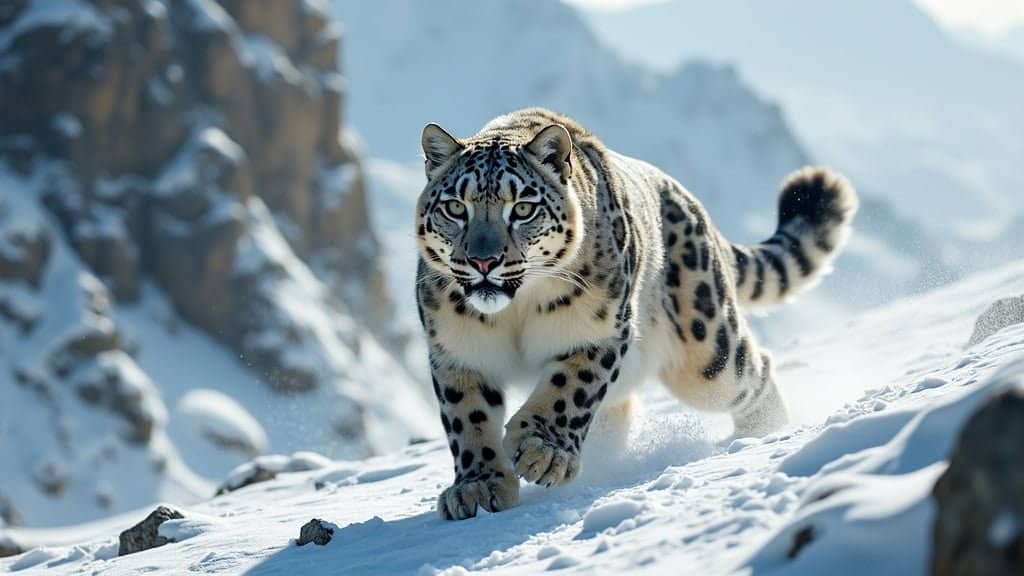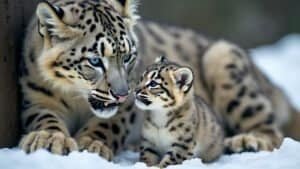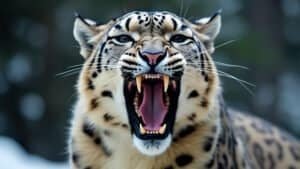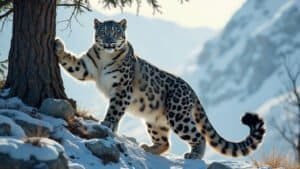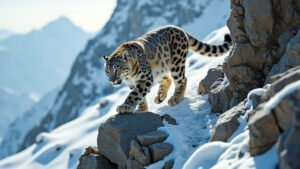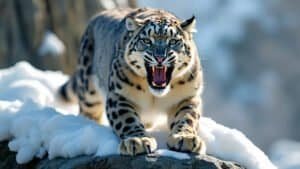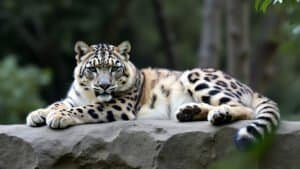Introduction
Snow leopards are known for their elusive nature and ability to survive in some of the harshest environments on Earth. These majestic big cats must manage their energy resources carefully to sustain themselves during long hunts, especially in the cold, high-altitude regions they inhabit
This article will explore the unique adaptations that allow snow leopards to conserve energy, the strategies they use while hunting in mountainous terrain, how their diet supports their energy needs, and the influence of their environment on their overall energy management
Adaptations for Energy Conservation
Snow leopards are remarkable predators, uniquely adapted to survive in the rugged and harsh environments of Central and South Asia’s mountain ranges
These big cats have developed several physical and behavioral adaptations that enable them to conserve energy during long hunts, ensuring their survival in such challenging habitats
Understanding these adaptations sheds light on the incredible efficiency and resilience of snow leopards in managing their energy resources
Physical Traits for Endurance
One of the most significant adaptations that snow leopards possess is their powerful, muscular build. This physical strength allows them to navigate steep, rocky terrain with minimal energy expenditure, a crucial trait given their high-altitude habitats
Their long, thick tails serve multiple purposes; not only do they aid in balance as the cats maneuver across treacherous landscapes, but they also function as a blanket during rest periods, helping to conserve body heat and energy in freezing temperatures
Their dense fur, which provides excellent insulation, is another key adaptation. The fur is thicker and longer on the underbelly, protecting vital organs from the cold ground as the leopards rest between hunts
Additionally, the unique structure of their nasal passages warms the cold mountain air before it reaches the lungs, reducing the energy required to maintain body temperature
Efficient Hunting Techniques
Snow leopards have evolved hunting strategies that prioritize energy efficiency. Unlike many other big cats that rely on short bursts of speed to chase down prey, snow leopards utilize stealth and patience
They often position themselves above their prey, waiting for the perfect moment to strike. This approach minimizes the energy expended during the hunt, as they use gravity to their advantage when pouncing on unsuspecting animals
The leopard’s hunting success rate is also linked to its ability to close in on prey undetected, reducing the need for long chases that could deplete its energy reserves. By remaining concealed within their rocky surroundings, snow leopards can ambush their prey with precision, often securing a meal with minimal physical exertion
The Role of Fat Reserves
Another crucial aspect of energy conservation in snow leopards is their ability to store and utilize fat reserves. During periods of scarcity, such as in the winter months when prey is less abundant, these fat stores become vital
Snow leopards can survive on the energy provided by these reserves, allowing them to endure longer periods between successful hunts. The accumulation of fat, particularly in the tail, provides an essential buffer against starvation, enabling these predators to maintain their health and hunting capabilities even in the harshest conditions
Moreover, snow leopards have a slower metabolic rate compared to other big cats, which helps them to conserve energy over extended periods. This lower metabolic demand means that they can survive on fewer calories, an adaptation that is particularly advantageous in environments where food is not always readily available
Hunting Strategies in Mountainous Terrain
Snow leopards have mastered the art of hunting in some of the most challenging terrains on Earth
The rugged, mountainous environments they inhabit require specialized strategies to capture prey effectively while conserving energy. These strategies, honed over millennia, allow snow leopards to remain apex predators in their high-altitude domains
Stealth and Patience
In the steep, rocky landscapes of the Himalayas, Tian Shan, and other mountainous regions, snow leopards rely heavily on stealth and patience
Unlike predators that hunt in open plains, where speed and stamina are crucial, snow leopards depend on their ability to remain undetected until the perfect moment to strike
Their spotted coats, which blend seamlessly with the rocky surroundings, provide exceptional camouflage, allowing them to get incredibly close to their prey without being noticed
A snow leopard’s typical hunting strategy involves slowly and quietly stalking its prey, often using the natural cover provided by rocks, cliffs, and vegetation
The terrain’s unevenness is a strategic advantage, as it allows the leopard to approach from above, reducing the distance and energy needed to launch a successful attack. This stealth-based approach minimizes the need for long, energy-draining pursuits and maximizes the chances of a successful kill
Tracking and Ambush Techniques
Snow leopards are solitary hunters, and their ability to track prey over long distances is vital for their survival. They use their keen sense of smell and acute vision to follow the movements of their prey, often over several miles
Once a target is identified, the leopard will take its time to study the prey’s behavior and movement patterns, looking for the right moment to attack. This careful observation ensures that the leopard can strike when the prey is most vulnerable, often at the moment when it least expects danger
Ambush is the cornerstone of a snow leopard’s hunting technique. By positioning itself on higher ground, often on a ledge or cliff above a herd, the leopard can leap down onto its prey with lethal precision
This tactic not only surprises the prey but also allows the snow leopard to use gravity to its advantage, reducing the energy required to overpower its victim. This method of ambush hunting is especially effective in the snow leopard’s mountainous environment, where the terrain can be used to enhance the element of surprise
Energy Expenditure During Hunts
While snow leopards are capable of short bursts of speed, these powerful sprints are rarely needed in their hunts. Instead, their hunting style focuses on minimizing energy expenditure
The decision to pursue prey is often made after careful consideration of the potential energy cost versus the reward. If a potential prey animal is too far or too alert, a snow leopard may abandon the hunt rather than risk wasting valuable energy on a low-chance pursuit
When a snow leopard does commit to a chase, it is typically brief and calculated. The terrain plays a crucial role in these moments, with the leopard using its knowledge of the landscape to corner or trap its prey, often driving it towards a dead-end or cliff where escape is impossible
This strategic use of the environment ensures that the energy expended during the hunt is kept to a minimum, allowing the leopard to remain efficient even in its most physically demanding activities
Diet and Energy Management
The diet of snow leopards plays a crucial role in their overall energy management, providing the necessary fuel for survival in their demanding environments
Snow leopards have adapted their eating habits and dietary preferences to ensure they obtain the maximum amount of energy from their food, helping them sustain prolonged hunts and endure harsh conditions
Prey Selection and Energy Yield
Snow leopards are opportunistic carnivores, primarily preying on medium-sized ungulates such as blue sheep (bharal), ibex, and argali. These animals are well-suited to the leopard’s high-altitude habitat, and their large size provides a substantial amount of energy with each kill
A single successful hunt can provide enough food to sustain a snow leopard for several days, reducing the need for frequent hunting and allowing the leopard to conserve energy
In addition to large prey, snow leopards also hunt smaller animals, including marmots, hares, and birds, especially when larger prey is scarce
These smaller prey items are easier to catch but offer less energy per hunt, which means the snow leopard must carefully balance its efforts with the nutritional returns. By targeting a mix of prey, snow leopards can optimize their energy intake while minimizing unnecessary energy expenditure
Eating Patterns and Metabolism
Once a snow leopard has successfully captured its prey, it exhibits a unique feeding behavior that maximizes energy efficiency. Snow leopards are known to eat large quantities at once, consuming up to 20 pounds of meat in a single meal
After such a feast, the leopard may rest and digest for several days, allowing it to replenish its energy reserves without expending additional effort
Their metabolic rate is adapted to this pattern of feast and rest. Snow leopards have a relatively low basal metabolic rate compared to other big cats, which means they can survive longer periods without food
This adaptation is particularly important during winter months when prey is less available. By slowing down their metabolism, snow leopards can stretch their energy reserves over longer periods, ensuring they have enough fuel to survive until the next successful hunt
The Importance of Nutrient-Rich Prey
The quality of the prey is just as important as the quantity. Snow leopards need nutrient-rich prey to maintain their health and strength, especially given the demanding conditions of their environment
Prey animals that are rich in fat and protein are particularly valuable, as they provide the necessary nutrients for muscle maintenance, energy storage, and overall vitality
During the winter, when the availability of prey decreases, snow leopards may rely more heavily on the fat reserves they have built up from consuming nutrient-rich prey earlier in the year. This stored energy is crucial for survival during lean times, and the leopard’s ability to metabolize fat efficiently ensures it can endure long periods without fresh kills
Furthermore, the specific nutrients found in their prey, such as taurine, are essential for maintaining the snow leopard’s vision, heart function, and reproductive health. This makes the leopard’s dietary choices critical not just for immediate energy needs, but also for long-term survival and reproduction
Environmental Influence on Energy Use
The harsh and variable environments in which snow leopards live have a significant impact on their energy use and overall survival strategies
From the challenges posed by high altitudes to the seasonal changes in temperature and prey availability, snow leopards must constantly adapt their behavior and physiology to conserve energy and thrive in their rugged habitats
Impact of Altitude and Climate
Snow leopards are native to some of the highest mountain ranges in the world, including the Himalayas, Karakoram, and the Pamirs, where altitudes can exceed 18,000 feet
At such high elevations, the air is thinner, containing less oxygen, which can make physical exertion more challenging. To cope with these conditions, snow leopards have evolved a range of physiological adaptations that allow them to function efficiently in low-oxygen environments
One such adaptation is their large nasal cavities, which warm and humidify the cold, dry air before it enters their lungs, reducing the energy cost of respiration. Additionally, their blood has a higher concentration of hemoglobin, allowing them to transport oxygen more effectively throughout their body. These traits are vital for sustaining energy levels during both rest and activity in oxygen-poor environments
The climate in these regions is also extreme, with temperatures plunging well below freezing, particularly in winter. To conserve energy, snow leopards reduce their activity levels during the coldest periods, often resting in sheltered areas where they can avoid exposure to the elements
Their thick fur, which is one of the densest of any cat species, provides insulation against the cold, further helping them to conserve energy by maintaining body heat with minimal metabolic effort
Seasonal Variations in Energy Needs
The changing seasons bring fluctuations in temperature, prey availability, and snow cover, all of which influence the energy dynamics of snow leopards. In the warmer months, prey is more abundant, allowing snow leopards to hunt more frequently and build up fat reserves in preparation for the winter
During this time, the leopards are more active, as they need to take advantage of the increased availability of food to ensure they have sufficient energy stores to survive the leaner months
As winter approaches, the snow cover increases, making it more difficult for snow leopards to find and hunt prey. The cold also means that maintaining body temperature requires more energy. To counteract this, snow leopards reduce their activity levels and rely more heavily on their fat reserves
They may also shift their hunting strategies, focusing on smaller prey that is easier to catch in the snow or targeting livestock when wild prey is scarce, despite the risks posed by human-wildlife conflict
Adaptations to Harsh Weather Conditions
In addition to their physical adaptations, snow leopards have developed behavioral strategies to cope with the harsh weather conditions of their environment. One key strategy is their ability to choose the right time and place to hunt
Snow leopards often hunt during dawn and dusk, when the weather is cooler but not at its coldest, balancing the need to conserve energy with the need to catch prey
They also seek out microhabitats that offer some protection from the elements, such as caves, rocky outcrops, or dense vegetation. These areas provide shelter from the wind, snow, and cold, allowing the leopards to rest and recover between hunts without expending excessive energy to stay warm
The selection of these resting spots is critical, as it ensures that the snow leopard can maintain its energy reserves and avoid unnecessary exposure to the elements
Additionally, snow leopards are known to migrate to lower altitudes during the harshest winter months. This seasonal movement allows them to avoid the most extreme cold and take advantage of lower elevations where prey may still be available, albeit in smaller numbers
By adjusting their location according to the season, snow leopards optimize their energy use, ensuring they can survive and reproduce in one of the planet’s most challenging environments
Conclusion
Snow leopards are extraordinary creatures, uniquely adapted to thrive in some of the world’s most challenging environments. Their ability to manage energy resources efficiently during long hunts is the result of a combination of physical adaptations, strategic hunting techniques, and a diet tailored to their demanding lifestyle
From their muscular build and efficient respiratory systems to their stealthy hunting methods and reliance on fat reserves, snow leopards demonstrate a remarkable capacity to conserve energy in high-altitude, harsh climates
The environment they inhabit significantly influences their behavior and energy use, requiring them to be constantly adaptable to seasonal changes and the varying availability of prey
Understanding these energy management strategies provides a deeper appreciation of the resilience and survival skills of these elusive big cats, highlighting the delicate balance they maintain in their rugged mountain homes
